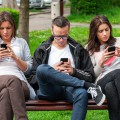
Some 92% of Americans own a cellphone, according to Pew Research Center. Of those who own, 31% say they never turn them off and 45% say they rarely do.
With an estimated 92% of American adults now owning cellphones that many report never turning off, the call for mobile-first strategies in business circles has truly reached its age.
Even so, the prevalence of smartphone use in daily life has also given rise to a number of sticky etiquette issues that are changing the face of social interactions, according to a newly released Pew Research Center survey.
To look into the impact smartphones and cellphones have had on social norms, the center recently conducted a national American Trends Panel Survey. That survey involved some 3,217 American adults, 3,042 of whom happen to be cellphone users.
Researchers conducted the survey between May 30, 2014, and June 30, 2014, to gain insights on just how, when and where Americans are using their cellphones and the social implications of the growing trend.
The Always-On Reality
As Pew learned, some 92% of Americans now report owning a cellphone of some type. Of those who own, 31% say they never turn them off and 45% say they only rarely do.
The new reality, Pew pointed out has transformed some long-standing social norms, pushing the boundaries of when it’s appropriate to turn attention away from physical encounters for interactions in the digital world.
Pew found that people generally don’t have hard-and-fast rules for appropriateness of engaging in digital encounters. The acceptability instead seems to hinge on the situation. For example:
- Some 77% of adults say it’s acceptable to be on cellphones while walking down a street
- 75% says it’s acceptable to use phones while on public transit
- Only 38% say it’s OK to use cellphones in restaurants
- Family dinners are also considered mostly sacred, with only 12% of respondents saying it’s OK to use phones during them
- Just 5% say cellphone use during meetings or in a movie theater is OK
You Might Also Enjoy: Study: Most Teens have Smartphones and Go Online Every Day
Americans Aren’t Always Practicing What They Preach
When it comes to cellphone use during social gatherings, Pew researchers found most people feel the practice can be a hindrance. Despite the belief, some 89% of cellphone owners admitted they used their phones during the most recent gathering they happened to attend.
The types of activities the 89% engaged in included:
- Reading emails or text messages, 61%
- Taking photos or videos, 58%
- Sending text or email messages, 52%
- Receiving incoming calls, 52%
- Checking alerts, 34%
- Placing a call, 33%
- Using an app, 29%
- Surfing the web, 25%
While the figures defy the stated belief that cellphone use in social settings disrupts gatherings, researchers found the whys behind the use rather enlightening. While some 16% reported they used their phones because they had lost interest in the social gathering, others said their use was tied directly to the event:
- 45% posted pictures or videos of the gathering
- 41% used phones to share something that had occurred in the group
- 38% used phones to find information they thought would interest the group
- 31% used phones to connect with people who are known to the group
Regardless of the social impacts, Americans are rapidly adopting an “always on” mentality, Pew found. In some cases, this new mindset serves to enhance face-to-face interactions, but in others it turns attention away from the physical reality for the digital world.
The full implications are not fully known, but as cellphone use reaches near market saturation levels, social norms are likely to continue to feel the push of change.





